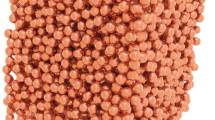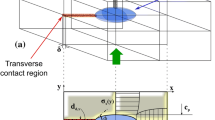Abstract
Grain growth in porous ceramics is a complex process due to the variety of interactions between pores and grains. In this study, the pore deformation and grain boundary migration during porous ceramic sintering are simulated by the phase-field method, and the variety of diffusions during sintering is considered. Pores of different shapes and sizes are induced into the simulations to investigate the grain boundary migration and pore deformations during grain growth. Simulation results indicate that the porous microstructure is determined by the contacting mode between pore surface and grain boundaries, which is in good agreement with experimental observations. The efficiency of the grain boundary migration is analyzed via calculating the forces applied on the interfaces between grains and pores, and the mechanism of the pore deformation during grain boundary migration is discussed. Therefore, controlling the grain–pore microstructure by adjusting the synthesis process is essential to reach the desired mechanical and physical properties of sintered materials.









Similar content being viewed by others
References
Saggio-Woyansky J, Scott CE, Minnear WP (1992) Processing of porous ceramics. Am Ceram Soc Bull 71:7758–7761
Barea R, Osendi MI, Ferreira JMF, Miranzo P (2005) Thermal conductivity of highly porous mullite material. Acta Mater 53:3313–3318
Chen Z, Lu C (2005) Humidity sensors: a review of materials and mechanisms. Sens Lett 3:274–295
Brandon NP, Brett DJ (2006) Engineering porous materials for fuel cell applications. Philos Trans R Soc Math Phys Eng Sci 364:147–159
Shimizu T, Matsuura K, Furue H, Matsuzak K (2013) Thermal conductivity of high porosity alumina refractory bricks made by a slurry gelation and foaming method. J Eur Ceram Soc 33:3429–3435
R.W. Rice, Porosity of ceramics, M. Dekker, 1998
Xue W, Huang Y, Xie Z, Liu W (2012) Al2O3 ceramics with well-oriented and hexagonally ordered pores: the formation of microstructures and the control of properties. J Eur Ceram Soc 32:3151–3159
Ahmed K, Yablinsky CA, Schulte A, Allen T, El-Azab A (2013) Phase field modeling of the effect of porosity on grain growth kinetics in polycrystalline ceramics. Model Simul Mater Sci Eng 21:2848–2855
Chockalingam K, Kouznetsova VG, Sluis OVD, Geers MGD (2016) 2D Phase field modeling of sintering of silver nanoparticles. Comput Methods Appl Mech Eng 312:492–508
Braginsky M, Tikare V, Olevsky E (2005) Numerical simulation of solid state sintering. Int J Solids Struct 42:621–636
Svoboda J, Riedel H (1992) Pore-boundary interactions and evolution equations for the porosity and the grain size during sintering. Acta Metall Mater 40:2829–2840
Du L, Zhang P, Wang L, Zheng B, Du H (2017) Phase field simulation on the effect of micropore morphology on grain growth in porous ceramics. Comput Mater Sci 131:196–201
Ning P, Feng Y, Ying J (2017) The synthesis and characterization of porous structured ZnFe2O4 particles with enhanced photocatalytic activity. Mater Res Express 4:055013
Zhang XY, Lan T, Li N, Wu JM, Huo WL, Ma N, Yang JL (2016) Porous silica ceramics with uniform pores from the in situ foaming process of silica poly-hollow microspheres in inert atmosphere. Mater Lett 182:143–146
Zhang XY, Wu JM, Yang JL (2015) Pore morphology designs of porous Si3N4-based ceramics using Si3N4 and Al2O3 poly-hollow microspheres as pore-forming agents. Mater Lett 144:39–42
Hou Z, Ye F, Liu L (2015) Effects of pore shape and porosity on the dielectric constant of porous β-SiAlON ceramics. J Eur Ceram Soc 35:4115–4120
Pia G, Casnedi L, Sanna U (2015) Porous ceramic materials by pore-forming agent method: an intermingled fractal units analysis and procedure to predict thermal conductivity. Ceram Int 41:6350–6357
Guo R, Wang C-A, Yang A (2011) Effects of pore size and orientation on dielectric and piezoelectric properties of 1–3 type porous PZT ceramics. J Eur Ceram Soc 31:605–609
Parhami F, Mcmeeking RM, Cocks ACF, Suo Z (1999) A model for the sintering and coarsening of rows of spherical particles. Mech Mater 31:43–61
Maximenko AL, Olevsky EA (2004) Effective diffusion coefficients in solid-state sintering. Acta Mater 52:2953–2963
Yamashita T, Uehara T, Watanabe R (2005) Multi-layered potts model simulation of morphological changes of the neck during sintering in Cu–Ni system. Mater Trans 46:88–93
Ahmed K, Allen T, El-Azab A (2016) Phase field modeling for grain growth in porous solids. J Mater Sci 51:1261–1277. https://doi.org/10.1007/s10853-015-9107-9
Ahmed K, Pakarinen J, Allen T, El-Azab A (2014) Phase field simulation of grain growth in porous uranium dioxide. J Nucl Mater 446:90–99
Mino Y, Ishigami T, Kagawa Y, Matsuyama H (2015) Three-dimensional phase-field simulations of membrane porous structure formation by thermally induced phase separation in polymer solutions. J Membr Sci 483:104–111
Biner SB (2017) Programming phase-field modeling, 1st edn. Springer, Berlin
Ha JH, Ahmad R, Song IH (2012) A novel method of coating a particle-stabilized alumina foam on a porous alumina substrate. Mater Lett 88:40–42
Tang Y, Miao Q, Qiu S, Zhao K, Hu L (2014) Novel freeze-casting fabrication of aligned lamellar porous alumina with a centrosymmetric structure. J Eur Ceram Soc 34:4077–4082
Rui MN, Seabra MP, Labrincha JA (2014) Ceramic tiles with controlled porosity and low thermal conductivity by using pore-forming agents. Ceram Int 40:11637–11648
Bakarič T, Rojac T, Abellard AP, Malič B, Levassort F, Kuscer D (2016) Effect of pore size and porosity on piezoelectric and acoustic properties of Pb(Zr0.53Ti0.47)O3 ceramics. Adv Appl Ceram 115:66–71
Du L, Yang S, Zhang P, Du H (2018) Pinning effect of different shape second-phase particles on grain growth in polycrystalline: numerical and analytical investigations. Compos Interfaces 25:357–368
Nes E, Ryum N, Hunderi O (1985) On the Zener drag. Acta Metall 33:11–22
Moelans N, Blanpain B, Wollants P (2008) Quantitative analysis of grain boundary properties in a generalized phase field model for grain growth in anisotropic systems. Phys Rev B 78:024113
Hartland P, Crocker AG, Tucker MO (1988) Grain growth with boundary pores. J Nucl Mater 152:310–322
Nourbakhsh S (1992) Pinning of grain boundaries by deformable particles. Metall Trans A 23:1181–1186
Song X, Liu G (1999) Computer simulation of normal grain growth in polycrystalline thin films. J Mater Sci 34:2433–2436. https://doi.org/10.1023/A:1004514816530
Thompson CV, Carel R (1996) Stress and grain growth in thin films. J Mech Phys Solids 44:657–673
Thompson CV (1990) Grain growth in thin films. Annu Rev Mater Res 20:245–268
Acknowledgements
This work was supported by the National Natural Science Foundation of China (Grant Numbers: 51501146, 51372197, 21503165, 51701152, 51705415, 51602252), the Cultivating Research Program of Xi’an University of Science and Technology (Grant Number: 201701), the Key Innovation Team of Shaanxi Province (Grant Number: 2014KCT-04) and the Undergraduate Training Program for Innovation and Entrepreneurship of XUST (Grant Number: 201710704160).
Author information
Authors and Affiliations
Corresponding authors
Rights and permissions
About this article
Cite this article
Du, L., Yang, S., Zhu, X. et al. Pore deformation and grain boundary migration during sintering in porous materials: a phase-field approach. J Mater Sci 53, 9567–9577 (2018). https://doi.org/10.1007/s10853-018-2267-7
Received:
Accepted:
Published:
Issue Date:
DOI: https://doi.org/10.1007/s10853-018-2267-7




